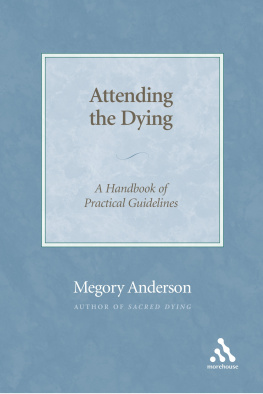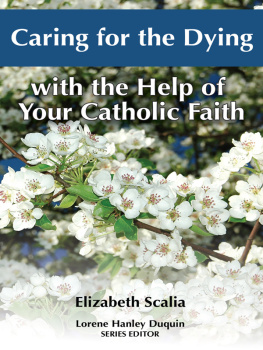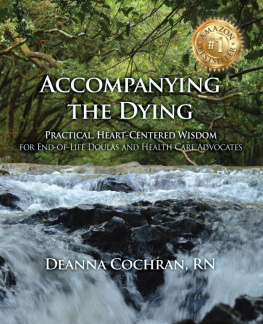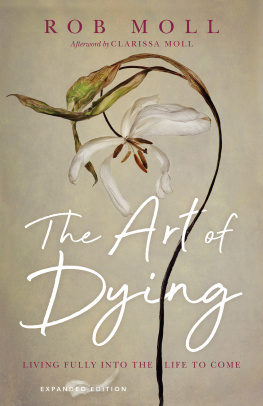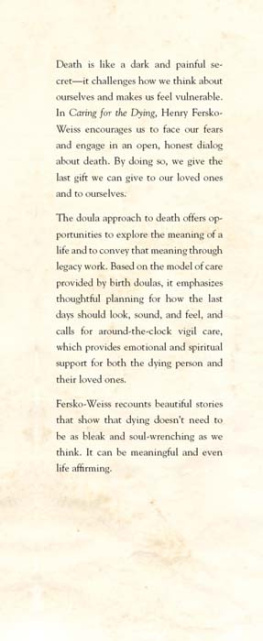Attending the Dying
A Handbook of Practical Guidelines
Megory Anderson
My profound gratitude goes to Chris Bennett, my friend and colleague, for her many hours of assistance in the creation of this book. Her knowledge and skill are on every page. She will tell you that she is not the expert in the sacred art of dying, but she truly has the higher wisdom. Thank you, Chris.
My thanks also goes to the Reverend Nancy Witt for her contribution of the very practical information in Appendix B, "Recognizing and Understanding the Dying Process." As a health care professional and ordained clergy, she combines very practical medical information with a greater understanding of the spiritual process of dying.
Special thanks to the staff, board, volunteers, and friends of the Sacred Dying Foundation. This work would not be brought to life without their support and hard work.
Special Circumstances
1. When a Person Is to Be
Taken Off Life Support
Circumstances
More and more, people at the end of their lives are being supported by artificial means. Families and loved ones have to make difficult decisions along the way in accepting feeding tubes, respirators, and other technical means of support while medical treatment continues. Unfortunately, when treatment is no longer effective, it is also up to family members to make the decision that will end the life of their loved one.
Taking someone off life support is an action that can be filled with anguish and guilt for the surviving family. Ironically, it is one of the more peaceful ways a person can die. The body, which has been supported by machines and technology, is suddenly allowed to shut down slowly and naturally. This gives the family time to prepare, both emotionally and spiritually, for the moment of death.
The chaplain or pastoral caregiver can assist the family during this time by working with medical personnel, who generally want the procedure to be as calm and supportive as possible, and by providing a spiritual framework for the entire process.
What You Can Do with the Dying Person
- Explain to the person on life support what is about to happen.
- Talk to the dying person, letting him or her know that it is time to let go.
- Pray on his or her behalf.
- Say good-byes on his or her behalf.
- Offer strength and courage for the journey.
- Perform whatever sacramental rituals (anointing, communion, etc.) are appropriate.
What You Can Do with the Loved Ones
- Create a prayerful atmosphere and a sacred space.
- Allow them to say their good-byes.
- Include them in prayers and sacraments; make this an experience in which the dying person is surrounded by family and friends.
- After good-byes are said, begin the process of vigiling until death occurs.
Be Aware
- Work with the medical staff to understand the parameters of the procedure.
- Try to make this an intimate experience for the family, within the boundaries of the medical unit.
- Understand that once the machines are turned off, death may not happen instantaneously. Families often assume this will happen. Death can take hours or even a few days.
- Be aware that families may not want to be present when the machines are turned off.
- Be sensitive to the fact that families may not want to stay much longer after the machines are turned off.
- Recognize that the person on life support is experiencing a letting go, just like any other person who is dying. Support that process with sacred presence and prayer.
2. When Sudden Death Occurs
Circumstances
Many deaths happen suddenly and without warning. Some happen in emergency rooms and others happen on-site, either in the home or outside a hospital setting. If the person is at the hospital, medical teams go into emergency status and everything is done to save him or her. If death occurs, the chaplain is able to be present and perform any rituals needed. This is a very stressful time and you are often the go-between with the family and loved ones.
What You Can Do Depending on Location
If you are in the emergency room and death is imminent, the activities of medical personnel will take highest priority. You can, however, create a prayerful atmosphere out of the way of the team of workers. Sometimes that is all you can do. If possible, try to access the person's body and lay hands on him or her in prayer. The last rites are always appropriate, even from a distance. Decide whether it is more important to be with the person dying, creating a presence with prayer, or to be with the nearby loved ones. It actually may be more helpful to be in the same room as the person who is dying. Remember, this experience is about the dying person and what he or she is going through. You are the link to the spiritual, and you may have to claim that with assurance and authority.
If death is approaching rapidly and you are outside a medical facility, help the people nearby make any decisions about finding medical help or letting the person die naturally. Your role as chaplain or pastoral caregiver is once again to provide a spiritual space so that the person can die understanding and experiencing the presence of the Divine. Keep bringing the focus back to prayer and to God.
What You Can Do with the Dying Person
- Pray.
- Lay hands on the person in prayer.
- Find a place in the room to create a sacred space.
- Talk to the person who is dying in a calm and soothing voice.
- When death has occurred and the medical people leave, offer to begin preparation of the body.
What You Can Do with the Loved Ones
- Assure them that you will be present during medical procedures.
- Help them with their own prayers in the midst of their fear and anxiety.
- Help them focus on finding strength and courage for their dying loved one.
- Comfort them.
Be Aware
- You will take last place in the overall dynamics of the medical emergency.
- It is your job to find a place of peace in the midst of the chaos and fear.
- You cannot fix the situation. You can only be present.
Remember, again, that the priority is the person who is dying. In the midst of chaos, that person needs God's presence more than ever.
3. When You Arrive after Death Occurs
Circumstances
Most often, the chaplain or pastoral care worker is called after a death occurs. Either a person has died a short time ago and the family is on its way to be with the body, or the death occurred some distance away and the chaplain has been called to help the family or loved ones pastorally. In either situation, you are not present at the moment of passing.
What You Can Do
Your first inclination is, of course, to respond pastorally to the surviving loved ones, and that is always a chaplain's responsibility. However, there are things that you can do to help the person who has died, even after death has occurred. As discussed previously, preparing the body and sitting with it are always sacred experiences, providing time for family members to come to terms with what has happened and giving the soul an opportunity to make its transition.

